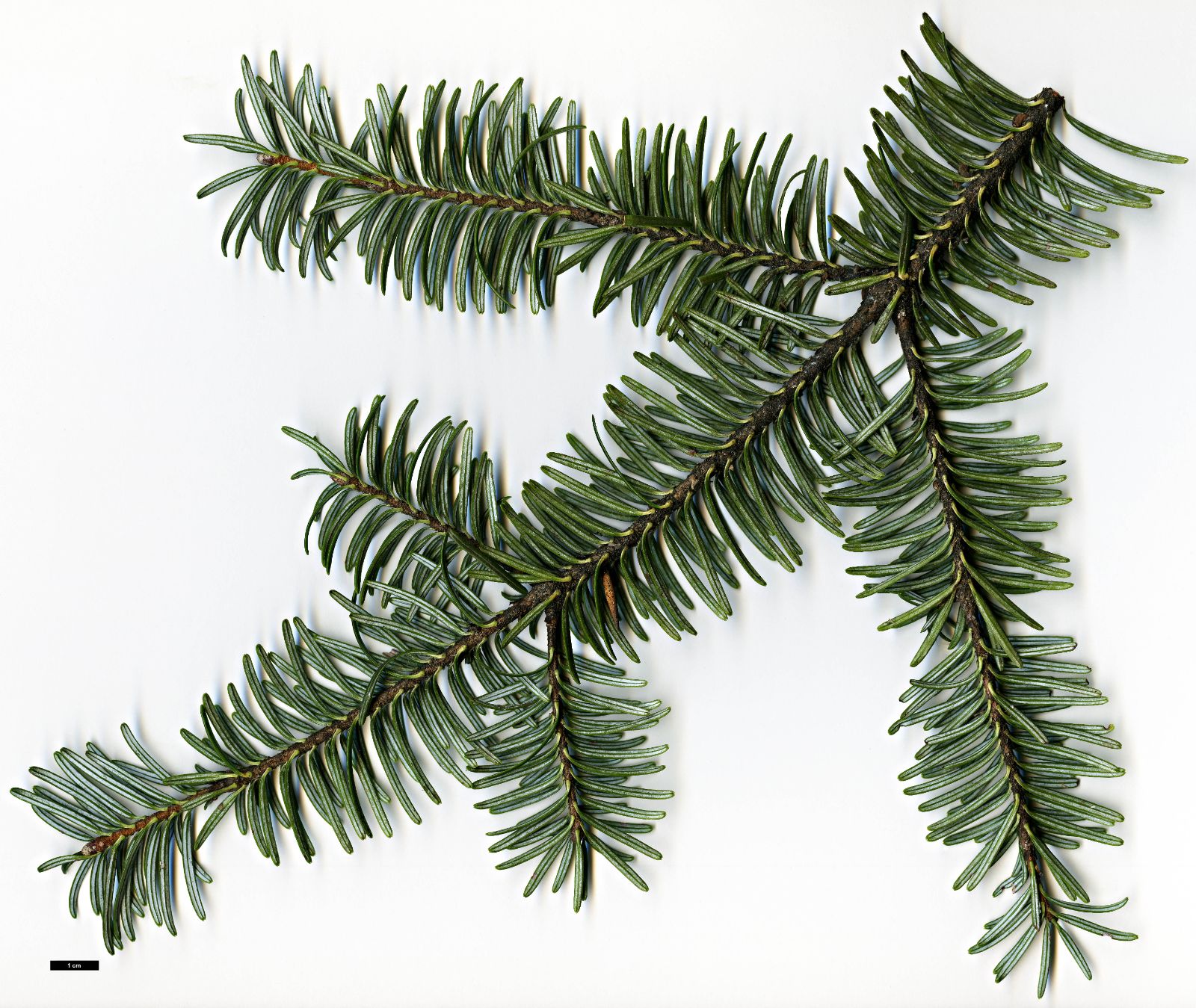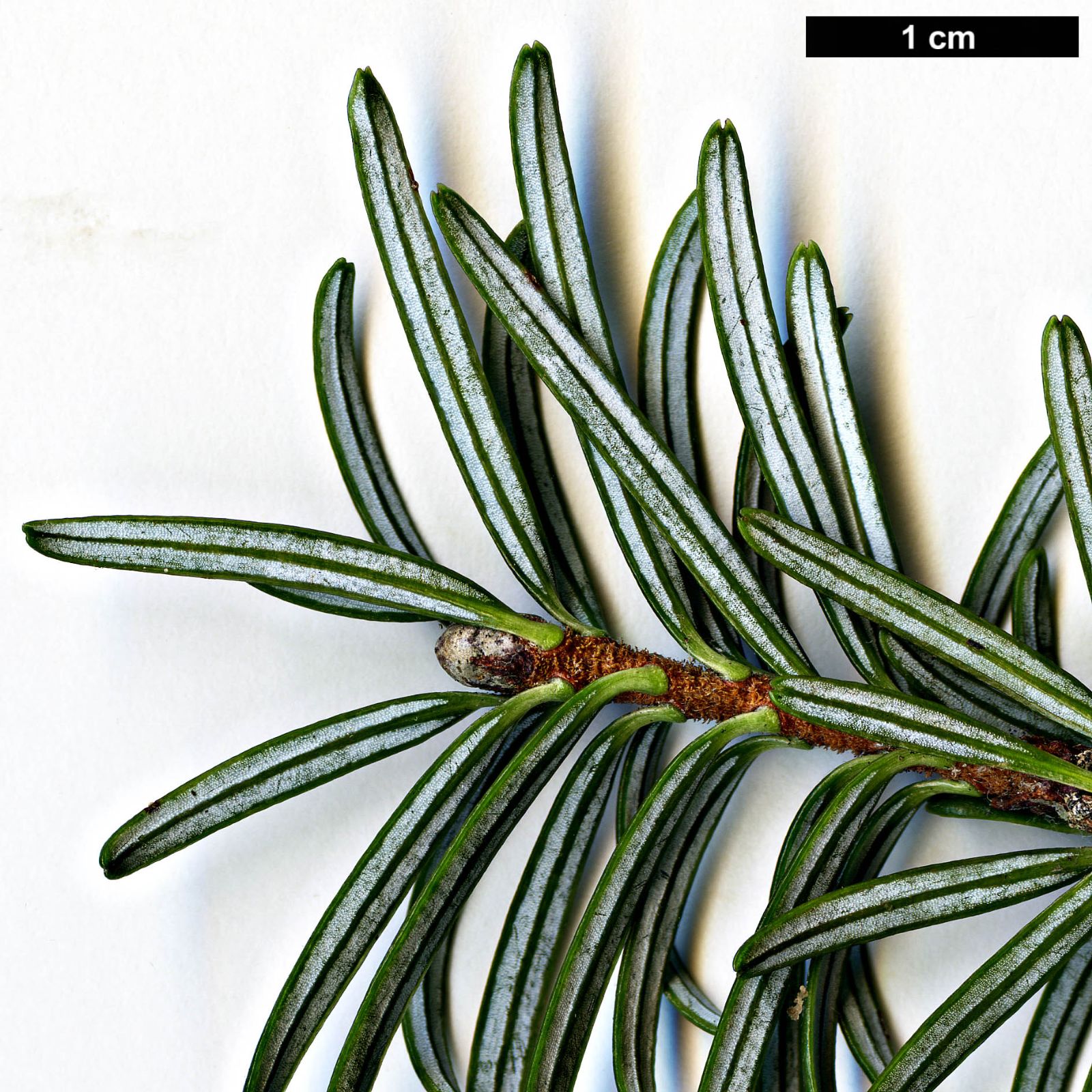Abies ferreana
Sponsor
Kindly sponsored by
Sir Henry Angest
Credits
Tom Christian (2021)
Recommended citation
Christian, T. (2021), 'Abies ferreana' from the website Trees and Shrubs Online (treesandshrubsonline.
Genus
Common Names
- Zhongdian Fir
- Zhongdian Lengshan
- Ferré Fir
Synonyms
- Abies forrestii var. ferreana (Bordères & Gaussen) Farjon & Silba
- Abies forrestii subsp. ferreana (Bordères & Gaussen) Silba
- Abies rolii Bordères & Gaussen
- Abies yuana Bordères & Gaussen
Infraspecifics
Other taxa in genus
- Abies alba
- Abies amabilis
- Abies × arnoldiana
- Abies balsamea
- Abies beshanzuensis
- Abies borisii-regis
- Abies bracteata
- Abies cephalonica
- Abies × chengii
- Abies chensiensis
- Abies cilicica
- Abies colimensis
- Abies concolor
- Abies delavayi
- Abies densa
- Abies durangensis
- Abies ernestii
- Abies fabri
- Abies fanjingshanensis
- Abies fansipanensis
- Abies fargesii
- Abies firma
- Abies flinckii
- Abies fordei
- Abies forrestii
- Abies forrestii agg. × homolepis
- Abies fraseri
- Abies gamblei
- Abies georgei
- Abies gracilis
- Abies grandis
- Abies guatemalensis
- Abies hickelii
- Abies holophylla
- Abies homolepis
- Abies in Mexico and Mesoamerica
- Abies in the Sino-Himalaya
- Abies × insignis
- Abies kawakamii
- Abies koreana
- Abies koreana Hybrids
- Abies lasiocarpa
- Abies magnifica
- Abies mariesii
- Abies nebrodensis
- Abies nephrolepis
- Abies nordmanniana
- Abies nukiangensis
- Abies numidica
- Abies pindrow
- Abies pinsapo
- Abies procera
- Abies recurvata
- Abies religiosa
- Abies sachalinensis
- Abies salouenensis
- Abies sibirica
- Abies spectabilis
- Abies squamata
- Abies × umbellata
- Abies veitchii
- Abies vejarii
- Abies × vilmorinii
- Abies yuanbaoshanensis
- Abies ziyuanensis
Tree to 20 m × 1 m dbh. Crown pyramidal in young trees; broad conical in mature trees. Bark grey and smooth at first, later grey-brown, developing fissures between longitudinal scales. Branchlets relatively slender (cf. A. forrestii, A. georgei), reddish-brown at first, densely ferruginous pubescent. Vegetative buds globose, resinous, smaller than in A. forrestii and A. georgei. Leaves pectinately arranged, parted beneath the shoot by a narrow or wide ‘V’, parted by a wide ‘V’ above on shaded shoots, otherwise somewhat assurgent with a proportion of needles upright above the shoot, 1–2.3 cm × 2–2.5 mm, base twisted, margins ~flat, apex emarginate, dark green above with two whitish stomatal bands beneath. Seed cones short-pedunculate, oblong to ovoid-cylindric, c. 5–8 × 3.5–4 cm; rich blue at first, maturing purplish-blue then bluish-black; seed scales flabellate-trapeziform, 1.6–2 × 1.6–2.2 cm at midcone; bracts oblong-cuneate-spathulate, exserted at maturity, apex rounded or emarginate, cusp erect at first, later erect, reflexed or recurved. (Debreczy & Rácz 2011; Fu, Li & Mill 1999; Bordères-Rey & Gaussen 1947).
Distribution China Very locally in NW Yunnan, SW Sichuan, and possibly SE Xizang (Tibet)
Habitat Mixed or coniferous temperate forests, 3300–4000 m asl.
USDA Hardiness Zone 6b
RHS Hardiness Rating H6
Conservation status Endangered (EN)
Taxonomic note Abies ferreana belongs to a confusing group of firs allied to A. forrestii; their diversity is introduced and contextualised in the article ‘Abies forrestii and its relatives’. A variety, var. longibracteata L.K. Fu & Nan Li, has been described based on bracts more prominently exserted with an acuminate (cf. rounded or emarginate) apex (Fu & Li 1997) but in a new approach this is treated as a synonym of A. georgei here. See the A. georgei article for discussion. A. rolii and A. yuana are treated as synonyms following Farjon (1990), Debreczy & Rácz (2011), and the Flora of China (Fu, Li & Mill 1999); a rare example of total alignment between those works. Farjon (2017) treats A. ferreana as a variety of A. forrestii and includes A. chayuensis as a synonym, but the Flora of China maintains A. chayuensis as distinct; Debreczy and Rácz do not discuss it. It is probably distinct but may not be in cultivation (K. Rushforth pers. comm. 2020).
Bordères-Rey & Gaussen named Abies ferreana in 1947 for the French botanist Yvette de Ferré (1915–2003) who at the time had ‘already published beautiful works on conifers’ (Bordères-Rey & Gaussen 1947). It remains a poorly understood species, reportedly ocurring very locally in scattered stands in the same general area as A. georgei. Prominent among the barriers to better understanding it is the fact that Bordères-Rey & Gaussen only cited a single specimen in their protologue (Yu 12326) (Bordères-Rey & Gaussen 1947). Furthermore, their description appears to mix and match foliar characters from sterile and coning shoots; the latter are known for exhibiting atypical and variable character states, such as resin canal position (see below). Nevertheless, A. ferreana remains the most appropriate name for material distributed in NW Yunnan, SW Sichuan, and perhaps SE Xizang (Tibet), fitting neither A. forrestii nor A. georgei.
Much has been made of the medial position of the resin canals in the leaves of fertile branches of A. ferreana. This is an oft-cited character, but a variable one in many species, and it should probably not be relied upon as absolutely diagnostic (Panetsos 1992; and see genus description for further discussion). Nevertheless, A. ferreana can be distinguished from other closely related species in the following ways: one-year shoots dark reddish-brown (cf. yellowish-grey or yellowish-brown or grey-brown in A. chayuensis); shoots densely pubescent (cf. glabrous in A. forrestii); winter buds pale golden-brown with a translucent resin (cf. covered in a thick, chalky, wax-like resin in A. georgei) (Bordères-Rey & Gaussen 1947). The shape of the apex (exserted part) of the bract scale is emarginate, abruptly tapering to a cusp; in this character A. ferreana is similar to A. forrestii and to some forms of A. georgei, but it differs from these in its smaller seed cones, typically 5–8 cm long (cf. 10–14 cm long) (Farjon 2017; Bordères-Rey & Gaussen 1947; Fu, Li & Mill 1999). The bract cusp of A. ferreana can be elongated and erect, and this could reasonably be assumed to be the inference behind the name var. longibracteata, but the type specimen of that taxon is clearly referable to A. georgei (see that article for discussion).
A. ferreana was introduced to cultivation in the early 20th century by Forrest and later by Kingdon-Ward (Rushforth 1987) but it is doubtful that any old trees remain in collections. Several introductions since 1980 have been tentatively identified as this species, but only KGB 503 and C&H 6158 appear to be genuine. As they mature, it may be that some of the BCHM gatherings of 2011 are identified as this species. In cultivation it seems to prefer the same general conditions as A. forrestii and A. georgei.
Abies chayuensis W.C. Cheng & L.K. Fu
Farjon (2017) treats A. ferreana as a variety of A. forrestii and includes A. chayuensis as a synonym, but the Flora of China maintains A. chayuensis as distinct; Debreczy and Rácz do not discuss it. It is probably distinct but may not be in cultivation (K. Rushforth pers. comm. 2020).




